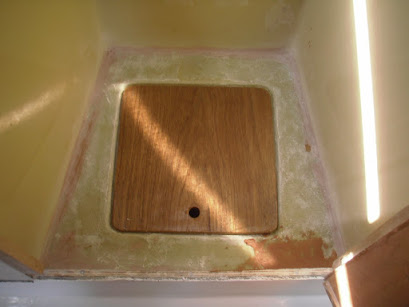The first job this week was to finish sanding the fairing compound on the heads sole, once I was happy with the finish I applied two coats of gelcoat followed by a single coat of flocoat. As the final coat is the same colour as the previous coats the most critical part of the job is making sure that the gelcoat is completely covered otherwise there will be areas where the gelcoat has not cured completely, however when I ran my hand over the sole this morning there were no sticky patches. Hopefully I have applied sufficient to enable me to sand back to leave a smooth finish.
Sole after gelcoat applied
As expected the finish is a bit rough which does not show up in the photograph.
The next job was to lay up three layers of biaxial cloth on the forward cabin sole which had suffered some cracking as well as a section having been cut away to allow the replacement of a section of the bulkhead under the cabin door.
Cracks just visible in corners of bilge access opening
Forward cabin sole
It can be seen that there is quite a gap between the moulding and the bulkhead the port side being much wider than the starboard and there is no evidence of the moulding being tabbed to the bulkhead. When I bought New Morning the sole had very little support especially as the upstand had been cut away which had led to the cracking in the corners of the bilge access opening. Some time ago in order to improve the situation I had screwed and glued a hardwood support to the bulkhead underneath the sole and then reinforced the corners of the opening with a couple of layers of CSM laid up from underneath the moulding, this had stopped any further flexing and damage. The plan now was to lay up three layers of 450g biaxial cloth over the sole and to form an upstand bonded to the bulkhead and then re gelcoat, however I found that 450g was far too heavy, the first layer was fine as it was made up of four sections but the subsequent layers in one piece could not be formed around the double bends of the bilge access opening, I had a similar problem with the heads sole, see last weeks post, but as the forward cabin sole is much smaller it was therefore much more difficult so in the end I called it a day with just the one layer, I shall have a rethink on Monday.

Forward cabin sole with one layer of biaxial cloth











